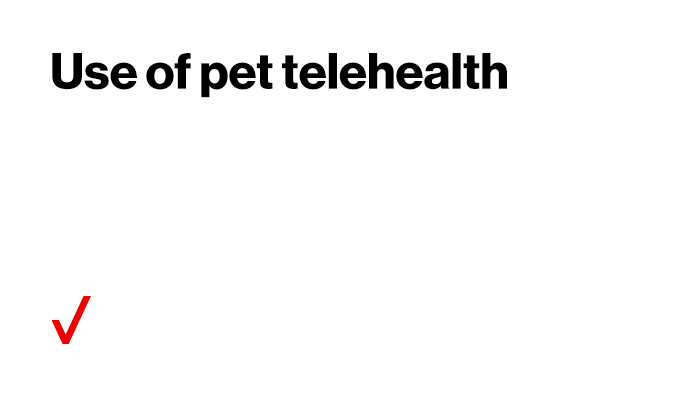Telehealth goes to the dogs
A rise in pet ownership during the pandemic, plus the convenience and care that pet telehealth services provide, could mean that the trend is here to “stay.” Good dog.
When Sara Carson’s border collie Hawkeye’s paw became inflamed, she thought she knew what was wrong but wanted a second opinion. No easy task for Carson, who has been traveling around the country in an RV since February.
“COVID put me out of a job, so I travel with my pets,” says Carson, who trains dogs and enters them in competitions. “We’ve been to 36 states since February. We’re currently in Kentucky, and we’re about to embark on a month-long adventure soon.”
Carson turned to a new trend in pet care: pet telehealth. She had only recently discovered a pet telehealth app, but decided that the situation with Hawkeye was the perfect chance to try it out. She grabbed her phone, opened the app, and within minutes was connected to a veterinarian virtually, despite being on the road somewhere in Montana.
“It’s so easy to use,” Carson says. “You just get connected to a vet and I’m able to show them my dog’s paw.”
In the end, the vet identified the problem as a spiky seed from foxtail, a kind of grass, that had gotten caught in Hawkeye’s fur. After confirming her suspicions with the vet, Carson was able to treat the wound herself.
“It was like 20 minutes because I had questions, but it was really quick to connect,” she says. “The vet was great and really personable and seemed to care about the dog.”
A new cause for the paws: Pet telehealth
While the pandemic has shifted many aspects of society further into the virtual world—from video work meetings to e-learning for students—healthcare has also become increasingly digital. Telemedicine apps saw a huge spike in downloads during 2020, with some apps seeing an increase of more than 8,000%, according to GlobalData.
Pet owners are starting to realize that the same convenience exists for their pets. And it’s a safer option for veterinarians as well.
“It also means veterinarians can serve clients without the restriction of potential health risks in clinic for non-clinic needs,” writes Cerys Goodall, vice president of operations at Vetster, when asked via email about pet telehealth services.
Claims submitted for pet telehealth services and phone consultations increased 379% between March 2020 and February 2021 compared to the same period one year earlier, according to data from the American Society for the Prevention of Cruelty to Animals (ASPCA) pet health insurance program. Daily downloads of virtual pet healthcare apps increased 40% in March 2020, according to a report by Forbes.
For less complicated situations like Hawkeye’s sore paw, Carson says, pet telehealth is perfect.
“It’s great for simple things like ‘my dog is limping’ or something like that,” she says. “I can just call the vet and get their opinion. Or like ‘my dog ingested something and they’re acting weird.’ It’s great if I have a question, or to get a second opinion. I could diagnose something like kennel cough.”
Shorter wait times at the vet
The average wait time for in-person visits at the vet in June 2019 nearly doubled in June 2020 during the pandemic. This could be due to the increase in pet adoptions last year or the change in many vet hospitals’ hours and increased safety measures. Because of these difficulties, pet owners often delayed or avoided going to the vet. That’s why many vets are recommending pet telehealth to their clients as well.
Jenny Bennett, the owner of Urban Tails Veterinary Hospital out of Durham, North Carolina, began offering telehealth in June 2020 when she opened her clinic.
“COVID has changed so much of what we do every day, and this is one example of that,” she says. “We use it for recheck appointments when we give pet owners information about how a lesion is healing or how a certain behavior modification technique is working. It enables clients we have a current veterinary/client/patient relationship (VCPR) with to get advice without having to leave the safety and comfort of their home.”
It gives the vets themselves flexibility as well, Bennett says.
“Telehealth visits decrease the amount of time we spend on certain appointments (rechecks, skin appointments, behavior follow-ups), making our business more efficient,” she says.
Less stress for pets
This new technology worked out for Jennifer Stas, a potter in Durham, who opted to use telehealth for her dog Poppy.
About a year ago, Stas noticed a rash between Poppy’s toes and decided to do a teleconference through TeleVet to connect with her local vet.
“I downloaded the app, set up the appointment, and then she calls you at that time,” Stas says. “I had an appointment half an hour after I made it. I told her what was going on and I showed her. She talked to me about it and what it was and ordered me a prescription, and it was shipped to my house the next day.”
Stas, who says she has used telehealth for herself, found that using virtual visits for Poppy was just as easy.
“I didn’t have to put her in the car, wrangle her, drive her, weigh her or have her stress out about being at the vet,” she says. “I didn’t have to take an hour off work. I just had to take 15 minutes to go inside and show her on the phone. It was fantastic.”
Stas has five pets total and says that going to the vet for all of them can be time-consuming and interrupts her workflow. With telehealth, she was able to get everything she needed, down to the medicine, from the comfort of her home and on her own time.
“It took 20 minutes at most,” Stas says. “It was really simple.”
A barking market
According to data from Softeq Development Corp., in 2020 the market value for pet telehealth services totaled around $92 million. And the largest share (37%) of the global pet telehealth market is in North America, according to data by Grand View Research. With pet ownership reaching 85 million families in 2020, an increase of 56% since 1988, virtual vet visits are likely to rise with the popularity of pets themselves, particularly for more straightforward situations like the ones that Carson’s and Stas’.
Both said that they would continue to use telehealth services for pets even after the pandemic.
“I think it’s great to give pet owners the accessibility on a phone,” Carson says. “It’s just like human telehealth.”
Need to keep an eye on your pets when you’re not home? Verizon’s smart home security systems could be your new best friend.

